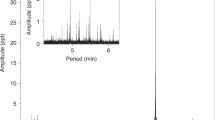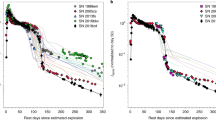Abstract
Type Ia supernovae are exploding stars that are used to measure the accelerated expansion of the Universe1,2 and are responsible for most of the iron ever produced3. Although there is general agreement that the exploding star is a white dwarf in a binary system, the exact configuration and trigger of the explosion is unclear4, which could hamper their use for precision cosmology. Two families of progenitor models have been proposed. In the first, a white dwarf accretes material from a companion until it exceeds the Chandrasekhar mass, collapses and explodes5,6. Alternatively, two white dwarfs merge, again causing catastrophic collapse and an explosion7,8. It has hitherto been impossible to determine if either model is correct. Here we report the discovery of an object in pre-supernova archival X-ray images at the position of the recent type Ia supernova (2007on) in the elliptical galaxy NGC 1404. Deep optical images (also archival) show no sign of this object. From this we conclude that the X-ray source is the progenitor of the supernova, which favours the accretion model for this supernova, although the host galaxy is older (6–9 Gyr) than the age at which the explosions are predicted in the accreting models.
This is a preview of subscription content, access via your institution
Access options
Subscribe to this journal
Receive 51 print issues and online access
$199.00 per year
only $3.90 per issue
Buy this article
- Purchase on Springer Link
- Instant access to full article PDF
Prices may be subject to local taxes which are calculated during checkout

Similar content being viewed by others
References
Riess, A. G. et al. Observational evidence from supernovae for an accelerating universe and a cosmological constant. Astron. J. 116, 1009–1038 (1998)
Perlmutter, S. et al. Measurements of omega and lambda from 42 high-redshift supernovae. Astrophys. J. 517, 565–586 (1999)
Nomoto, K., Thielemann, F.-K. & Yokoi, K. Accreting white dwarf models of Type I supernovae. III. Carbon deflagration supernovae. Astrophys. J. 286, 644–658 (1984)
Hillebrandt, W. & Niemeyer, J. C. Type Ia supernova explosion models. Annu. Rev. Astron. Astrophys. 38, 191–230 (2000)
Whelan, J. & Iben, I. Binaries and supernovae of type I. Astrophys. J. 186, 1007–1014 (1973)
Nomoto, K. Accreting white dwarf models for type I supernovae. I. Presupernova evolution and triggering mechanisms. Astrophys. J. 253, 798–810 (1982)
Iben, I. & Tutukov, A. V. Supernovae of type I as end products of the evolution of binaries with components of moderate initial mass (M not greater than about 9 solar masses). Astrophys. J. Suppl. 84, 335–372 (1984)
Webbink, R. Double white dwarfs as progenitors of R Coronae Borealis stars and type I supernovae. Astrophys. J. 277, 355–360 (1984)
van den Heuvel, E. P. J., Bhattacharya, D., Nomoto, K. & Rappaport, S. A. Accreting white dwarf models for CAL 83, CAL 87 and other ultrasoft X-ray sources in the LMC. Astron. Astroph. 262, 97–105 (1992)
Piersanti, L., Gagliardi, S., Iben, I. & Tornambé, A. Carbon–oxygen white dwarf accreting CO-rich matter. II. Self-regulating accretion process up to the explosive stage. Astrophys. J. 598, 1229–1238 (2003)
Saio, H. & Nomoto, K. Inward propagation of nuclear-burning shells in merging C–O and He white dwarfs. Astrophys. J. 500, 388–397 (1998)
Han, Z. & Podsiadlowski, P. The single-degenerate channel for the progenitors of type Ia supernovae. Mon. Not. R. Astron. Soc. 350, 1301–1309 (2004)
Yungelson, L. R. in White Dwarfs: Cosmological and Galactic Probes (eds Sion, E., Vennes, S. & Shipman, H.) 163–173 (Springer, Dordrecht, 2005)
Mannucci, F., Della Valle, M. & Panagia, N. Two populations of progenitors for type Ia supernovae? Mon. Not. R. Astron. Soc. 370, 773–783 (2006)
Scannapieco, E. & Bildsten, L. The type Ia supernova rate. Astrophys. J. 629, 85–88 (2005)
Leonard, D. C. Constraining the type Ia supernova progenitor: The search for hydrogen in nebular spectra. Astrophys. J. 670, 1275–1282 (2007)
Mattila, S. et al. Early and late time VLT spectroscopy of SN 2001el—progenitor constraints for a type Ia supernova. Astron. Astrophys. 443, 649–662 (2005)
Ruiz-Lapuente, P. The binary progenitor of Tycho Brahe's 1572 supernova. Nature 431, 1069–1072 (2004)
Pollas, C. & Klotz, A. Supernova 2007on in NGC 1404. Central Bureau Electronic Telegrams 1121, (2007)
Gal-Yam, A. et al. SN 2007on is probably a young type Ia event. Astron. Tel. 1263, (2007)
Tonry, J. L. et al. The SBF survey of galaxy distances. IV. SBF magnitudes, colors, and distances. Astrophys. J. 546, 681–693 (2001)
Immler, S. et al. Swift observations of SN 2007on. Astron. Tel. 1261, (2007)
Hamuy, M. et al. The absolute luminosities of the Calan/Tololo type IA supernovae. Astron. J. 112, 2391–2397 (1996)
Bregman, J. N., Temi, P. & Bregman, J. D. The ages of elliptical galaxies from infrared spectral energy distributions. Astrophys. J. 647, 265–275 (2006)
Li, Z., Han, Z. & Zhang, F. Potential of colors for determining age and metallicity of stellar populations. Astron. Astrophys. 464, 853–857 (2007)
Cowley, A. P. et al. Six supersoft X-ray binaries: System parameters and twin-jet outflows. Astrophys. J. 504, 854–865 (1998)
Yoon, S.-C., Podsiadlowski, P. & Rosswog, S. Remnant evolution after a carbon–oxygen white dwarf merger. Mon. Not. R. Astron. Soc. 380, 933–948 (2007)
Tutukov, A. V. & Yungelson, L. R. Double-degenerate semidetached binaries with helium secondaries: cataclysmic variables, supersoft X-ray sources, supernovae and accretion-induced collapses. Mon. Not. R. Astron. Soc. 280, 1035–1045 (1996)
Luna, G. J. M. & Sokoloski, J. L. The nature of the hard-X-ray emitting symbiotic star RT Cru. Astrophys. J. 671, 741–747 (2007)
Acknowledgements
We thank the Central Bureau for Astronomical Telegrams for providing a list of supernovae. This research has made use of data obtained from the Chandra Data Archive and software provided by the Chandra X-ray Center in the application package CIAO, and of Swift data obtained from the High Energy Astrophysics Science Archive Research Center, provided by NASA’s Goddard Space Flight Center. The observations from the NASA/ESA Hubble Space Telescope were obtained from the data archive at the Space Telescope Institute. We thank NOVA for support. G.N. is supported by an NWO VENI grant.
Author Contributions The authors have contributed equally to the paper.
Author information
Authors and Affiliations
Corresponding authors
Rights and permissions
About this article
Cite this article
Voss, R., Nelemans, G. Discovery of the progenitor of the type Ia supernova 2007on. Nature 451, 802–804 (2008). https://doi.org/10.1038/nature06602
Received:
Accepted:
Issue Date:
DOI: https://doi.org/10.1038/nature06602
This article is cited by
-
Portrait of a doomed star
Nature (2014)
-
A review of type Ia supernova spectra
Astrophysics and Space Science (2014)
-
Supernovae and Gaia
Astrophysics and Space Science (2012)
-
The companion properties of SNe Ia from the single degenerate model
Science China Physics, Mechanics and Astronomy (2011)
-
Exclusion of a luminous red giant as a companion star to the progenitor of supernova SN 2011fe
Nature (2011)
Comments
By submitting a comment you agree to abide by our Terms and Community Guidelines. If you find something abusive or that does not comply with our terms or guidelines please flag it as inappropriate.



